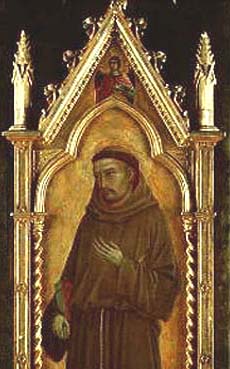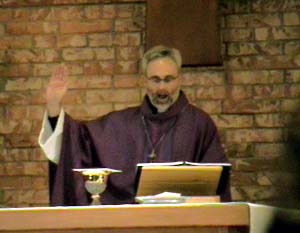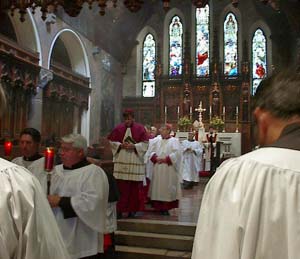 |
Faith under Attack
The Insidious Tactics of Change
Mark Stabinski
Some of the most insidious but subtle of assaults that have been perpetrated against Our Lord Jesus Christ's One True Faith by the scions of Vatican II have been against the actual Body, Blood, Soul and Divinity of Our Blessed Savior in the Sacrament of the Most Holy Eucharist.
The Catholic Faith's immutable profession of belief in the Real Presence of Our Lord Jesus Christ in the Holy Eucharist had been a 500- year-old "obstacle to our separated brethren" prior to Vatican II, according to the novel thinking of the revolutionaries.
To remove this obstacle or to raze this bastion in a manner both pleasing and acceptable to those who - once again, prior to Vatican II - were identified as apostates, heretics, schismatics, perfidious, pagans, and/or unbelievers, many strategies and tactics have been introduced and employed by those Modernists embedded in the Church for the last half century.
I invite you to look at this article on the Tradition in Action website entitled “Desecration of the Holy Eucharist by Using Large Hosts.” What our friends at TIA point out in this report is but one of the strategies introduced after the Second Vatican Council that is being used today to further diminish Catholic belief in the Real Presence while simultaneous building bridges with the remainder of the Eucharist-denying world.
Not only did these diverse sects of "separated brethren" deny the Real Presence but they likewise denied the sacrificial nature of the Holy Mass itself.

St. Francis of Assisi:
All, who have seen Jesus in the flesh, but have not seen Him after the Spirit and in His Divinity, and have not believed that He was really the Son of God, are doomed.
Also those are doomed who see the Sacrament of the Body of Christ, which is consecrated with the Words of the Lord on the Altar and by the hand of the priest in the form of bread and wine, but do not see in It the Spirit and Divinity and have not believed that It really is Our Lord Jesus Christ's most holy Body and Blood.
(Admonitio prima de Corpore Christi, apud Johannes Jorgensen, St. Francis of Assisi, New York: Longmans, Green & Co., 1912, p. 55.)
|
The catastrophic consequences of first professing and then implementing liturgical ‘reforms’ intended to validate these denials were recognized by some of Catholicism's greatest of Saints and Martyrs at the very beginning of the Protestant Revolution itself. For example, St. John Fisher stated, "He who goes about to take the Holy Sacrifice of the Mass from the Church plots no less a calamity than if he tried to snatch the sun from the universe.” (1)
St. John's assessment of this "calamity" - for which he was later beheaded – was not just his personal opinion. Nay, indeed, this Saint and Martyr was expressing truth voiced by a prophecy in Holy Scriptures:
“For from the rising of the sun even to the going down, my name is great among the Gentiles, and in every place there is sacrifice, and there is offered to my name a clean oblation: for my name is great among the Gentiles, says the Lord of hosts. And you have profaned it in that you say: The table of the Lord is defiled: and that which is laid thereupon is contemptible with the fire that devours.” (Mal 1: 11-12)
In Malachais, the God reveals to us the only future worship pleasing to Him:
- It must be daily, global and unceasing;
- It must be practiced by the Gentiles in His Name;
- It would involve a "clean oblation" (Our Lord Jesus Christ);
- It would be "defiled" by first, the Jews, and then in subsequent centuries by apostates, heretics and schismatics. All of these would deny Our Lord's bloodless "sacrifice" or, worse, would dare to call this Divine Sacrifice "contemptible."
Further, the Holy Ghost warns us that prior to the consummation of time and at
the end of the world: “The continual sacrifice shall be taken away, and the abomination unto desolation shall be set up.” (Dan 12: 11)
This horrific prophecy was re-echoed by the 19th century stigmatic and mystic, Blessed Anna-Katarina Emmerick: "I saw again the new and odd looking Church which they were trying to build. There was nothing holy about it... People were kneading bread in the crypt below ... but it would not rise, nor did they receive the Body of Our Lord, but only bread." (2)
Changing the liturgy
The periti who designed Vatican II realized that their radical plans of destruction might not be implemented by the Council documents. Even though they had managed to insert their bad ideas into the official documents of the Church, they knew that this alone would be insufficient. For most people, despite the new notions, things would go on much as before.

The Book of Common Prayer - Heretical and Novus Ordo Gospels read the same |
The only way to introduce into the hearts of the laity all these new ideas - which Paul VI termed "the new economy of the Gospel" - was by means of the liturgy. Here the innovators would have a captive audience every Sunday. Of course, they had planned long and well. Revolution is always well planned and directed by the upper strata of any group...
If the Novus Ordo Missae was to reflect the beliefs of the post-Conciliar Church and at the same time remain acceptable to Catholics brought up in the Ancient Faith, it had to:
- Avoid professing the new doctrines too openly, while expunging anything that contradicted them. At the same time, it could not deny any Catholic Doctrine directly - it could only dilute or expurgate it;
- Introduce changes slowly and retain enough of the outer trappings of a true sacrifice so as to give the impression that nothing significant was changed;
- Create a rite that for ecumenical reasons was acceptable to Protestants of every shade and persuasion. All of them, however, denied that the Mass was truly the unbloody Sacrifice of Calvary and that a "sacrificing" priest was necessary;
- Soften up Catholic resistance and introduce into the lives of the faithful the Modernist ideas promulgated by Vatican II.
The use of ambiguity
The only way that the Novus Ordo Missae could achieve all this was through the use of ambiguity. There is, however, nothing ambiguous about the traditional rites of the Church.
Thomas Cranmer used ambiguity in order to establish the Anglican-Protestant-Episcopalian sect in England. Pastor Dryander wrote to Zurich stating that the First Book of Common Prayer harbored 'every kind of deception by ambiguity or trickery of language.'
According to T. M. Parker, an Anglican theologian, the net result was that “the First Book of Common Prayer of Edward VI could not be convicted of overt heresy, for it adroitly framed and contained no express denial of pre-Reformation doctrine.”
It was an ingenuous 'essay in ambiguity,' purposely worded in such a manner that the more conservative could place their own construction upon it and reconcile their consciences to using it, while the Reformers would interpret it in their own sense and would recognize it as an instrument for furthering the next stage of the Revolution.'
Apart from the ambiguity, one must consider the numerous "deletions" which the post-conciliar innovators made - some 60 to 80 percent of the Traditional Rite depending upon which Eucharistic Prayer is used. These deletions, by the way, are precisely those which Martin Luther and Thomas Cranmer made - those relating to the Sacrificial Nature of the Mass.
Ambiguity, deletions and, lastly, mistranslations all were used to achieve the goals of the innovators' agenda.
Keeping the outer trappings
Another tactic was to retain the outer trappings of a Catholic Rite in the Novus Ordo Missae. Once again, there were plenty of precedents.

An Anglican procession with the Catholic "trappings" to fool the people |
Consider the following description of the early Lutheran service as given us by the great Jesuit scholar Hartmann Grisar:
"One who entered the parish church at Wittenberg after Luther's victory, discovered that the same vestments were used for divine service as of yore, and heard the same old Latin hymns. The host was elevated and exhibited at the consecration. In the eyes of the people, it was the same mass as before, despite the fact that Luther omitted all prayers which represented the sacred function of the sacrifice. The people were kept intentionally in the dark on this point.
“'We cannot draw the common people away from the Sacrament, and it will probably be thus until the Gospel is well understood,' said Luther. The rite of celebration of the mass, he explained, is a 'purely external thing,' and said further that 'the damnable words referring to the Sacrifice could be omitted all the more readily, since the ordinary Christian would not notice the omission and hence there was no danger of scandal.'"
The post-conciliar innovators followed the same pattern. As the authors of The Critical Study of the Novus Ordo Missae have noted: “Having removed the keystone, the reformers had to put up a scaffolding.”
After the Council, following the pattern established by Luther and Cranmer, changes were introduced, slowly at first, and then, at an increasing pace. Those victimized by the early days of "aggiornamento" will remember the almost weekly changes that were mandated.
Vatican II perito Cardinal Heenan bears witness to this, stating that we would have been 'shocked' if all the changes had been introduced at once. “Changes came, however, one on top of another, and still more are in the planning stage."(3)
More changes in the planning stage
"And still more are in the planning stage" – that is to say, there are still more rupturing and Faith-destroying changes in the stage of implementation.
How can I make this seemingly audacious claim? By citing these words by then Cardinal Joseph Ratzinger that have never been retracted:
"Luther's historical instinct is clearly proving itself right ... Both the Catholic and Protestant interpretation of Christianity have meaning each in its own way; they are true in their historical moment ... Truth becomes a function of time ... Fidelity to yesterday's truth consists precisely in abandoning it in assuming today's truth." (4)
Allow me, if you will, to provide one final citation from Audin's Life of Luther pertaining to the correctness of "Luther's historical instinct:"
"It is pertinent that Martin Luther tells us that it was Satan who convinced him that the Mass was not a true sacrifice, and that in worshipping bread, he was guilty of idolatry: ‘Listen to me, learned Doctor, during these 15 years you have been a horrible idolater. What if the body and blood of Jesus Christ is not present there, and that you yourself adored and made others adore bread and wine? What if your ordination and consecration were as invalid as that of the Turkish and Samaritan priest is false, and worship impious... What a priesthood is that!
“’I maintain, then, that you have not consecrated at Mass and that you have offered and made others adore simple bread and wine... If then, you are not capable of consecrating and ought not to attempt it, what do you do while saying Mass and consecrating, but blaspheme and tempt God?.’
“Luther acknowledged at the close of this conference that he was unable to answer the arguments of Satan, and he immediately ceased saying Mass." (5)
Yes, perhaps in the eyes of the Enemy of mankind, "Luther's historical instinct" is entirely correct – for the Evil One was the very source of it.
1. T. E. Bridgett, Life of Blessed John Fisher, London: Burnes Oates, 1888
2. Yves Dupont, Catholic Prophecy, p. 116
3. Rama P. Coomaraswamy, The Destruction of The Christian Tradition, pp. 255-257
4. Joseph Ratzinger, Principles of Catholic Theology, in ibid., p. 436
5. Apud Fr. Michael Muller, The Holy Sacrifice of the Mass.

Posted on June 8, 2009

Related Articles of Interest
 Luther: No! Absolutely No! Luther: No! Absolutely No!
 The October Revolution The October Revolution
 Non Possumus Non Possumus
 Card. Willebrands: Luther is our common master Card. Willebrands: Luther is our common master
 Ratzinger gives Communion to Protestant Roger Schultz Ratzinger gives Communion to Protestant Roger Schultz
 Schutz converted. You are wrong. Read the response Schutz converted. You are wrong. Read the response
 Paul VI with Protestants he invited to help write the New Mass Paul VI with Protestants he invited to help write the New Mass
 John Paul II kisses the hand of Rowan Williams John Paul II kisses the hand of Rowan Williams
 Protestant Oscar Cullmann considered Ratzinger a radical Protestant Oscar Cullmann considered Ratzinger a radical
 John Paul II preaching at the Anglican cathedral of Canterbury John Paul II preaching at the Anglican cathedral of Canterbury

Related Works of Interest
|
|
Faith under Attack | Religious | Home | Books | CDs | Search | Contact Us | Donate

© 2002-
Tradition in Action, Inc. All Rights Reserved
|
 |
|